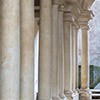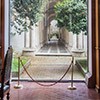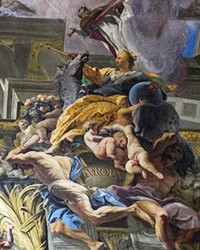Perspective Gallery of Palazzo Spada – fiction and reality, meaning architectural games with the senses

Francesco Borromini, Perspective Gallery of Palazzo Spada

Perspective Gallery of Palazzo Spada

Perspective Gallery of Palazzo Spada

Francesco Borromini, Perspective Gallery of Palazzo Spada
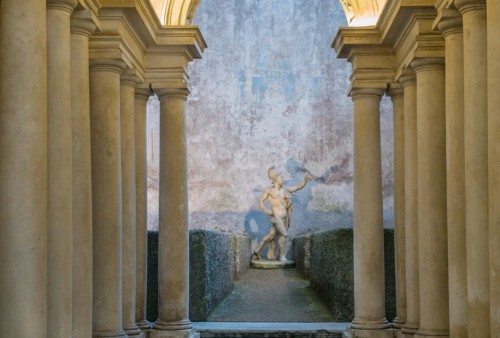
Perspective Gallery of Palazzo Spada, Francesco Borromini

Palazzo Spada, facade and main entrance to the palace

Palazzo Spada, courtyard
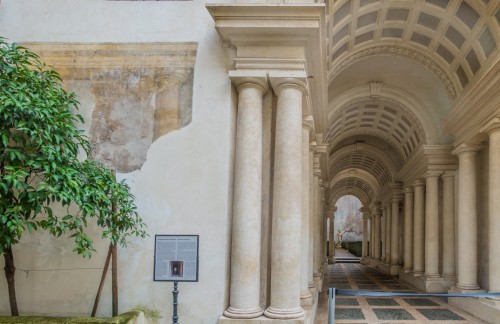
Francesco Borromini, Perspective Gallery of Palazzo Spada, fragment of ancient frescoes

Perspective Gallery of Palazzo Spada

Perspective Gallery of Palazzo Spada
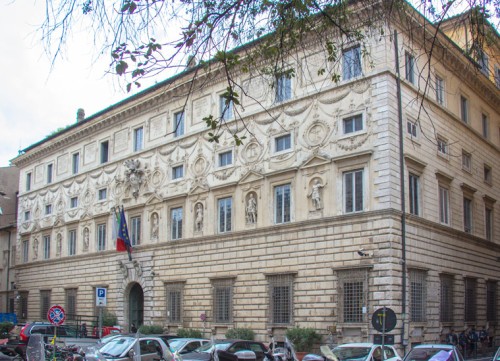
Palazzo Spada - seat of the Spad family

Palazzo Spada, passages between the garden and the main courtyard

Gian Lorenzo Bernini, Scala Regia in the Apostolic Palace

Portrait of Cardinal Bernardino Spada, Guercino, Galleria Spada
Several steps from the Campo de’Fiori we can see the residence of the Roman Spada family. When we stand in front of the imposing palace (Palazzo Spada), which is found on the small Piazza Capo di Ferro, the lack of the appropriate perspective will not allow us to fully appreciate the grandeur of its façade decorated with reliefs, stuccos, and statues. In front of us, we will have the raw, avant-corps wall of the ground floor, and if we decide to enter through the main gate, we will find ourselves in a magnificent broad courtyard.
Several steps from the Campo de’Fiori we can see the residence of the Roman Spada family. When we stand in front of the imposing palace (Palazzo Spada), which is found on the small Piazza Capo di Ferro, the lack of the appropriate perspective will not allow us to fully appreciate the grandeur of its façade decorated with reliefs, stuccos, and statues. In front of us, we will have the raw, avant-corps wall of the ground floor, and if we decide to enter through the main gate, we will find ourselves in a magnificent broad courtyard.
From the piano nobile niches we will have ancient gods looking down upon us, but this time we will not devote any attention to them, as our gaze travels to the left – and there, behind a glass gate, we will find the object of our pilgrimage – a colonnade. At first glance, it seems to be something thoroughly normal – a Baroque architectural structure, of which several more can be found in the Eternal City. This "normalcy" is however, an illusion – only when we reach the courtyard visible through the gate (after purchasing the ticket to the museum) and take a closer look at it, can we fully appreciate the deceptive intention of the architect and the client. Let us devote a few words to them before we describe and analyze the structure itself.

In 1632, the palace came into the possession of Cardinal Bernardino Spada, an ambitious and hard-working man. He also amassed a large enough fortune which allowed him to implement numerous projects of his and to buy equally many works of art for his collection. With enthusiasm, the cardinal began the modernization and reconstruction of his new residence in the new Baroque style. On the aforementioned side courtyard, he created a true Arcadia – a garden in which he had small bitter orange (melangolo) trees planted, with white, scented flowers, and fruits with wrinkled skin. This giardino segreto (secret garden) – a type of architectural arrangement very popular during the Renaissance and Baroque, also designated for the planting of flowers and herbs – was in the warm hours of the evening a place of repose and meetings with selected guests for the owner of the palace. It was used for discussions, feasts, and listening to music. The garden was found inside the palace complex and was separated from the street by a high wall. At that time, the interior could still be accessed directly from the palace.

On one of the walls surrounding the building, in 1642 the cardinal ordered an illusionistic painting imitating architecture to be painted (columns with Doric capitals, and porticos). Its author was a well-known painter and an expert in the field of optical illusion painting (quadrature) – Giovanni Battista Magni. However, when in the following years, the cardinal bought some more land, and a house neighboring the garden, and he came up with the idea of creating something truly exceptional, as if the architecture painted on the garden wall no longer satisfied him. He desired to take it a step further and entrusted making his vision a reality to the architect who had previously worked for him on the palace reconstruction Francesco Borromini. And so in 1652 in place of Magni's frescoes, a wall was torn down and a corridor was built leading to a small garden found at its end. The following year the small corridor was turned into something that had not been seen in Rome until then, the small became large, narrow became wide, and short became long. In it, Borromini created a gallery finished off with a coffered vault, which thanks to the appropriately planned perspective foreshortening gave the impression of being something that it was not. The eye of the onlooker does not notice that as he moves away from the gallery the floor of the corridor seems to be moving up, the ceiling lowers itself, and the Doric columns become smaller and smaller and seem to be nearer each other. Yet the numbers speak for themselves: while the arch of the colonnade at the entrance is almost six meters high and more than three meters broad, at the end it is only two and a half meters high and a meter wide. In this "miraculous" way the architect optically enlarged the colonnade five times – the small, merely 8.82 meters long corridor in the eyes of the viewer appears to be 35 meters long. The entire "deception" is best seen when somebody stands at the very end of the colonnade – only then can we see that the end columns are smaller than a man. If that was not enough the illusionistic paintings of Magni, which remained on the walls on either side of the colonnade (today preserved only in fragments) to an even greater degree deceived the logic of the human senses – nobody could be sure where reality began and where it ended. In this way, Borromini, taking advantage of the knowledge of the mathematician Giovanni Maria da Bitonto, created a sort of optical illusion – a forced perspective enabling the widening of small spaces and their enlargement in the eyes of the observer. Initially, the colonnade ended on the small courtyard (it is almost a skylight), much smaller than it seems, whose walls were covered with a painting of a landscape illuminated by the rays of the sun descending down upon it. Thanks to such a procedure, the colonnade seemed to be a passageway allowing access to an imaginary forest. It was not until the XIX century when a Roman warrior was placed in front of the wall – a sculpture that seems to have regular, human dimensions, but in reality is only 65 meters high.

Borromini was also tasked with one more thing by the cardinal – to strengthen the effect of surprise, the Church dignitary had him create a passage between the main garden and the main courtyard – the one through which we saw the gallery at the entrance. The colonnade seen from this perspective was able to additionally double its length, and further deceive our senses. Between the two courtyards, the cardinal's audience chamber was placed, which today is closed off with glass doors on both sides.

The man behind the creation of the colonnade was most likely Cardinal Spada himself, fascinated with optical illusions, geometry, and architecture, but also the questions regarding the limits of illusion. This should come as no surprise, as it was the time of the reign of illusionistic painting, the highly valued quadrature, and extravagant scenographic ideas of Gian Lorenza Bernini. It was then, that artists began playing with our senses, freeing space from physical and logical limitations, thanks to paintings "opening up" the vaults of churches to limitless skies, as was done by, for example, Andrea Pozzo in the Church of Il Gesù. He even claimed that the “eye is the wisest of the senses, but it has a strange desire to be deceived by the art of perspective”. And here we are only a step away from the question about the moral significance of this deception of the senses, to which the response may be the illusion of all that is earthly – importance, wealth, and fame.
Recommended: Empire of the Eye: The Magic of Illusion-Palazzo Spada's
https://www.youtube.com/watch?v=CX_S4_c5xJ0
If you liked this article, you can help us continue to work by supporting the roma-nonpertutti portal concrete — by sharing newsletters and donating even small amounts. They will help us in our further work.
You can make one-time deposits to your account:
Barbara Kokoska
BIGBPLPW 62 1160 2202 0000 0002 3744 2108 or support on a regular basis with Patonite.pl (lower left corner)
Know that we appreciate it very much and thank You !
























